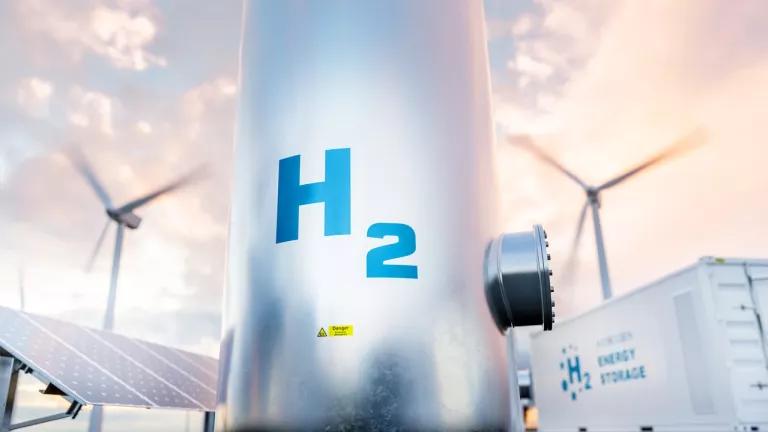To Reach Historic Climate Goals, Decarbonize U.S. Industry
One area the Biden administration has rightly prioritized for climate action is the U.S. industrial sector, which will be key to achieving our climate targets and to revitalizing America’s manufacturing sector.

In a historic announcement, President Biden has pledged that the U.S. will slash greenhouse gas emissions at least 50% below 2005 levels by 2030, aligning the country with international efforts to limit global warming to 1.5°C. One area the Biden administration has rightly prioritized for climate action is the U.S. industrial sector, which will be key to achieving our climate targets and to revitalizing America’s manufacturing sector. Today’s pledge highlights opportunities to invest in advanced technologies that could prove transformational in meeting this challenge, such carbon capture and sequestration efforts at industrial facilities, and underscores the major role government procurement can play in creating early markets for low-and zero-carbon industrial goods.
Like the power, transportation, and buildings sectors, decarbonizing U.S. industry is critical to achieving near-term climate targets. NRDC’s modeling underscores that cleaning up industry is both necessary and possible, and represents one of four key opportunities to cut carbon pollution (see figure below from our issue brief). To achieve at least 50% economy-wide GHG savings by 2030, industrial emissions must fall by one-third below 2005 levels.
The industrial sector is responsible for roughly one-third of U.S. emissions when accounting for direct and indirect (i.e., electricity-use) emissions. With the right set of investments, incentives and standards, the industrial sector can help us meet – or even exceed – the president’s goal. This package of policies can also help create new industrial methods that will support economic development and new jobs in a vital part of the American manufacturing base.
Decarbonizing the industrial sector will not be easy: It is heavily dependent on fossil fuels, extremely diverse and encompasses complex supply chains. Most industrial emissions come from the production of a small set of carbon-intensive products, including basic chemicals, iron and steel, cement, aluminum, glass, and paper. Industrial facilities, which often cluster in low-income and minority communities, are also a major source of other air and water pollution.
Beyond 2030, zeroing out emissions from industrial sub-sectors like cement and steel will require a broad mix of strategies. This includes relying on existing solutions like energy efficiency measures and electric boilers to supply low-temperature steam for various industrial processes, and scaling up the deployment of new and emerging technologies, such as industrial carbon capture, utilization and storage (CCUS). Increasing numbers of industries are committing to zero-emissions plans and deploying new technologies to achieve that goal.
Unfortunately, industrial sector research and development is dramatically underfunded relative to its contribution to emissions—and relative to its challenges to decarbonization. The administration and Congress should invest in dedicated, long-term funding for R&D and demonstration projects to improve industrial-sector climate solutions. Congress has taken the first steps to increase industrial sector innovation, but we need greater investment to match the scale of the challenge and take advantage of decarbonization opportunities in the sector.
The Energy Act of 2020, enacted late last year, included the Clean Industrial Technologies Act, which authorized and expanded industrial innovation programs at the Department of Energy, including largescale demonstration projects to commercialize technologies to cut pollution from industrial facilities. Congress should now appropriate funding to support the expanded program and demonstration projects. The infrastructure package under discussion in Congress should also include supplemental funding for industrial sector decarbonization demonstration projects. The funding reflected in the American Jobs Plan appears to be a very positive indicator that this is an administration priority.
In addition, the Energy department needs several additional updates to better tackle industrial decarbonization. First, funding for industrial sector R&D should grow to at least three times today’s budget to match the need for investment. Second, industrial sector work should be elevated to a higher level, including a new Assistant Secretary for industry. Third, the department’s Advanced Manufacturing Office needs the funding, capacity, and attention to expand beyond energy efficiency to also dedicate resources to electrification, hydrogen, CCUS for industrial applications, novel processes, and other solutions to meet this critical challenge.
President Biden should also use his executive authority to leverage the enormous purchasing power of the federal government to build markets for greener industrial products. This can be done by signing a “Buy Clean” Executive Order that requires all construction projects receiving federal funds to take climate pollution (and labor protection) into account when awarding contracts. A big infrastructure push, such as that outlined in the American Jobs Plan, can and should go hand in hand with a requirement to purchase low-carbon industrial building materials like concrete, cement, and steel.
The opportunity to reduce industrial emissions is immense. Consider that the American Jobs Plan calls for modernizing 20,000 miles of highways and roads, fixing the ten most economically significant bridges, and repairing the worst 10,000 smaller bridges. By our estimates, rebuilding that many miles of highways and fixing that many bridges could require more than 20 million metric tons of cement.
If the federal government flexed its purchasing power to require that cement be even just 10 or 15% less carbon-intensive than average—which is well within the range of feasibility given commercially-available and cost-effective decarbonization options available today—that alone could reduce emissions by the equivalent of taking nearly 500,000 to 750,000 cars off the road for a year. And that’s not even accounting for the additional emissions reductions that procurement standards could achieve across the suite of other industrial buildings materials that will play a central role in any big national infrastructure push.
Any Buy Clean program (whether enacted via executive action or legislation) should also include incentives for companies to go beyond minimum requirements when supplying industrial building materials for federally funded projects. This can be done by blending Buy Clean with a competitive bidding mechanism based on climate performance, as in the Low Embodied Carbon Concrete Leadership Act (LECCLA). This act focuses on concrete procurement and applies discounts to project bids with the lowest embodied emissions, as well as those that feature breakthrough technologies—for example, carbon capture and utilization at cement plants or carbon mineralization in concrete. Doing so will be critical to ensuring that big investments in U.S. infrastructure help to continuously pull the most innovative decarbonization solutions into the market.
The urgency reflected in the Biden administration’s 2030 commitment—and the urgent need to drive our whole economy towards net-zero emissions—means we cannot afford to delay efforts to decarbonize the industrial sector. We must also ensure that climate progress in the sector helps American companies lead in manufacturing the low- and zero-carbon industrial materials and applications of the future. Done right, industrial policies are not only critical to achieving climate targets but are an important tool for economic development—a way to keep and grow industry in the United States.




